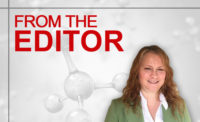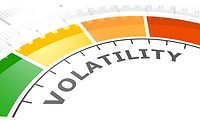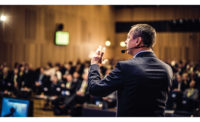2022 Voices from the Top: Adhesive & Sealant Industry Insights
To develop Voices from the Top, we reached out to key leaders at some of the top adhesive and sealant companies to get their insights on a number of issues.

(Photo courtesy of gremlin via gettyimages.com.)
Jayshree Seth, Corporate Scientist and Chief Science Advocate, 3M

Jayshree Seth, corporate scientist and chief science advocate for 3M, giving a keynote at the 2022 World Adhesive and Sealant Conference. (Photo courtesy of The Adhesive and Sealant Council, Inc.)
Myriad adhesives, sealants, and related products (e.g., tapes, films, wound care/closure products) are produced in each of 3M’s four business segments: Safety & Industrial (representing 36% of 3M’s total 2021 net sales of $35.4 billion), Transportation & Electronics (28%), Health Care (26%), and Consumer (17%). 3M is ranked number 2 on the 2022 ASI Top 20.
Jayshree Seth, who serves as 3M’s corporate scientist and chief science advocate, recently gave a keynote presentation during the 2022 World Adhesive and Sealant Conference. Her topic focused on “Sticking with Science! The Need for STEM Advocacy,” and she shared her thoughts following the event.
You mentioned “science for community” near the beginning of your talk. Why is this concept so important to 3M?
Science for community is one of the pillars in our sustainability framework at 3M. We are very active in the communities we operate in around the world. The work 3M does to make an impact on local communities makes me proud to work for the company.
One of many examples is that last year 3M announced a global, education-focused goal to advance economic equity by creating five million unique STEM and skilled trade learning experiences for underrepresented individuals by the end of 2025. We are aligned with the United Nations Sustainable Development Goals (UN SDGs) and are committed to creating a diverse science community and a more positive world with science.
At 3M, we apply science in collaborative ways to improve lives and help solve some of the toughest challenges. 3M science powers the world around us, and we take a community-first approach in every initiative we put forth and also in every product we manufacture.
What are the key findings of the 2022 State of Science Index?
We recently released the 2022 3M State of Science Index results. It’s the fifth year of this third-party, independent research we do to explore global attitudes toward science. At a high level, this year’s State of Science Index underscores that science will continue to impact our lives in the “next normal” era—in ways that are tangible, highly relevant, and deeply personal. Living through the pandemic has positively impacted the public’s appreciation and trust in science, and over the next five years, more than half the world expects to appreciate science more than they do today. These sentiments are even stronger among Millennials and Gen Z, which gives me tremendous hope for the future of science.
We also continued to track overall global trust in science. This year, we found people looking for science to provide solutions to major social issues from sustainability to health and STEM equity challenges.
Diving deeper into the findings from this year’s index, trust in science remains exceptionally high throughout the world, and younger generations are more likely to put their complete trust in science and recognize its importance in their everyday lives. Despite the positive news for science, our research revealed that the public believes misinformation is pervasive in news and social media, which may pose a threat to scientific credibility.
But, if misinformation is a big threat to scientific credibility, social impact is the next big opportunity for science. Climate change, for one, is becoming increasingly personal and a majority of people are more concerned about climate change, air pollution, and intensifying national disasters than they were last year.
We also found that improving access to quality healthcare is considered the number-one priority for most countries, and is something people want society, corporations, and science to prioritize. And, while interest in STEM education and careers remains high, diversity in science and equal access to a quality STEM education remain barriers for many, particularly underrepresented minorities and women.
How can the adhesive and sealant industry help expand people’s perception of science?
We know from our State of Science data that when science is relatable to people, they tend to be more interested and appreciative. Obviously, most consumers are not waking up in the morning thinking about adhesives and sealants. But when scientists communicate about innovations that focus on the outcomes and benefits of adhesives, vs. the science itself, it can be more interesting, relatable, and can help draw them in.
I believe context is key in making people appreciate the crucial role adhesives and sealants play in everyday life. When I joined 3M almost three decades ago, I was working on diaper tapes. The adhesive science involved in achieving the right properties to meet all the performance requirements is quite complex, but when asked what I was working on, I would start with the human context—I am working on tapes that help the diapers stay put on wiggly babies!
What role can science/STEM play in the industry’s talent acquisition and retention efforts?
The contextual importance of science and its connection to societal goals can play an enormous role in attracting the next generation of talent. However, we also need to level the playing field for people of all genders, races, and backgrounds. While we are breaking down barriers, we still need diverse scientists today to be more visible so that the younger generation can say, “If I can see it, I can be it.”
There’s still not enough people of color and women in many scientific fields. Our research found 87% of people around the world believe it’s important to increase DE&I in STEM fields, and 88% of people say the scientific community should do more to attract a diverse workforce.
However, many people aren’t seeing representation gaps that clearly exist in the STEM workforce. The perception doesn’t match the reality. Our 2022 study found that only 53% of people believe a gender gap exists in the STEM workforce; only 44% believe there is a racial gap; and only 39% see a LGBTQ+ gap. We need greater acknowledgment of these gaps to work on closing them. The world believes we’ll see results if we can improve DE&I in the STEM workplace, and 84% of people say science companies would have a greater impact on society if there was greater diversity and representation within their workforce.
I’m proud to share the belief that greater diversity will lead to greater impact, which is why I’m such a passionate advocate for breaking down barriers and stereotypes to help women, girls, and racial minorities enter the field. Last year, 3M premiered a docuseries, Not the Science Type, featuring four diverse women scientists, and I am honored to be one of the scientists featured in it. With this docuseries we want to inform, influence, and hopefully inspire by showing that we can all be the science type regardless of gender, race, age, or ethnicity.
I have written about this, and related topics, in my books available on Amazon, The Heart of Science series: Engineering Footprints, Fingerprints, & Imprints and Engineering Fine Print. Sales proceeds from both books go to a scholarship for underrepresented minority women in STEM administered by Society of Women Engineers (SWE).
For more information about 3M, visit www.3m.com. To explore the full State of Science Index results, visit www.3m.com/scienceindex.
View Other Participants:
Looking for a reprint of this article?
From high-res PDFs to custom plaques, order your copy today!






